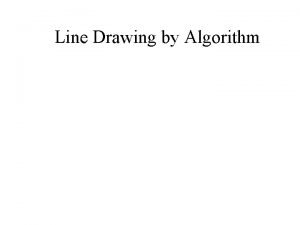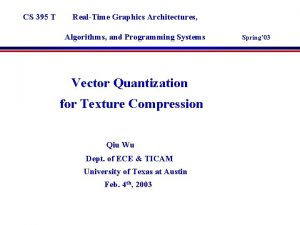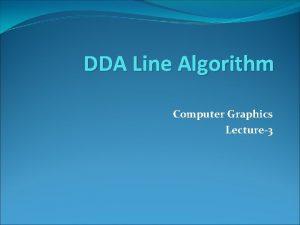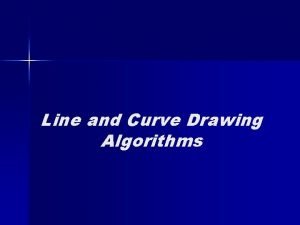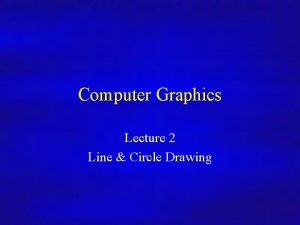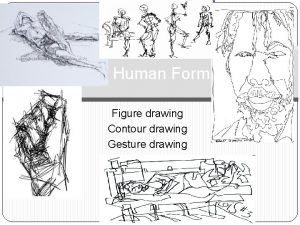Line Drawing Algorithms A line in Computer graphics























- Slides: 23

Line Drawing Algorithms A line in Computer graphics is a portion of straight line that extends indefinitely in opposite direction. 2. It is defined by its two end points. 3. Its density should be independent of line length. the slope intercept equation for a line: y = mx + b (1) where, m = Slope of the line b = the y intercept of a line 1.

The two endpoints of a line segment are specified at positions (x 1, y 1) and (x 2, y 2). y P 2(x 2, y 2) P 1(x 1, y 1) b 0 x

We can determine the value for slope m & b intercept as m = y 2 -y 1/x 2 -x 1 i. e. m= Δy/ Δx (2)

Example 1 The endpoints of line are(0, 0) & (6, 18). Compute each value of y as x steps from 0 to 6 and plot the result. Solution : Equation of line is y= mx +b m = y 2 -y 1/x 2 -x 1= 18 -0/6 -0 = 3 Next the y intercept b is found by plugging y 1& x 1 into the equation y = 3 x + b, 0 = 3(0) + b. Therefore, b=0, so the equation for the line is y= 3 x.

The challenge is to find a way to calculate the next x, y position by previous one as quickly as possible.

DDA Algorithm The Digital differential analyzer (DDA) algorithm is an incremental scan-conversion method. Such an approach is characterized by performing calculations at each step using results from the preceding step.

Algorithm: (x 1, y 1) (x 2, y 2) are the end points and dx, dy are the float variables. Where dx= abs(x 2 -x 1) and dy= abs(y 2 -y 1) (i) If dx >=dy then length = dx else length = dy endif

(ii) (iv) (vi) (vii) dx = (x 2 -x 1)/length dy = (y 2 -y 1)/length x = x 1 + 0. 5 y = y 1 + 0. 5 i=0 Plot ((x), (y)) x = x + dx y = y + dy i=i+1

(viii) If i < length then go to step (v) (ix) Stop Example 2 Scan convert a line having end points (3, 2) & (4, 7) using DDA. Solution: dx= x 2 - x 1 = 4 -3 = 1 dy= y 2 - y 1 = 7 -2 = 5 As, dx < dy then length = y 2 -y 1 = 5 dx = (x 2 -x 1)/ length = 1/5 =0. 2 dy = (y 2 -y 1)/ length = 5/5 = 1

x 1 y 1 x 2 y 2 L dx dy i x 3 2 4 7 5. 2 1 0 3. 5 1 3. 7 2 3. 9 3 4. 1 4 4. 3 5 4. 5 y 2. 5 3. 5 4. 5 5. 5 6. 5 7. 5 Result 3. 5, 2. 5 3. 7, 3. 5 3. 9, 4. 5 4. 1, 5. 5 4. 3, 6. 5 4. 5, 7. 5 Plot 3, 2 3, 3 3, 4 4, 5 4, 6 4, 7

Limitations of DDA: (1) The rounding operation & floating point arithmetic are time consuming procedures. (2) Round-off error can cause the calculated pixel position to drift away from the true line path for long line segment.


The Bresenham Line Algorithm � The Bresenham algorithm is another incremental scan conversion algorithm � The big advantage of this algorithm is that it uses only integer calculations

The Big the Idea Move across x axis in unit intervals and at each step choose between two different y coordinates For example, from position (2, 3) we have to choose between (3, 3) and (3, 4) We would like the point that is closer to the original line 5 (xk+1, yk+1) 4 (xk, yk) 3 (xk+1, yk) 2 2 3 4 5

Deriving The Bresenham Line Algorithm At sample position xk+1 theyk+1 dupper vertical separations from the mathematical line are labelled dupper and dlower y yk dlower xk+1 The y coordinate on the mathematical line at xk+1 is:

The Bresenham Line Algorithm BRESENHAM’S LINE DRAWING ALGORITHM 1. Input the two line end-points, storing the left end-point in (x 1, y 1) 2. Calculate the constants Δx i. e. dx, Δy i. e. dy, 2Δy and 2 Δx, get the first value for the decision parameter as: 3. 4. Initialise starting Initialise i=1 as a counter,

The. Otherwise, Bresenham Algorithm the next. Line point to plot is (xk+1, (cont…) yk+1) and: 5. Repeat step 4 (Δx – 1) times ACHTUNG! The algorithm and derivation above assumes slopes are less than 1. for other slopes we need to adjust the algorithm slightly.

Adjustment For m>1, we will find whether we will increment x while incrementing y each time. After solving, the equation for decision parameter pk will be very similar, just the x and y in the equation will get interchanged.

Bresenham Example Let’s have a go at this Let’s plot the line from (20, 10) to (30, 18) First off calculate all of the constants: �Δx: 10 �Δy: 8 � 2Δy: 16 � 2Δy - 2Δx: -4 Calculate the initial decision parameter p 0: �p 0 = 2Δy – Δx = 6

Bresenham Example (cont…) k p 18 k 17 0 16 1 15 2 14 3 4 13 5 12 6 11 7 10 8 20 21 22 23 24 25 26 27 28 29 30 9 (xk+1, yk+1)

Bresenham Exercise Go through the steps of the Bresenham line drawing algorithm for a line going from (21, 12) to (29, 16)

Bresenham Exercise (cont…) k p 18 k 17 0 16 1 15 2 14 3 4 13 5 12 6 11 7 10 8 20 21 22 23 24 25 26 27 28 29 30 (xk+1, yk+1)

Bresenham Line Algorithm Summary The Bresenham line algorithm has the following advantages: �An fast incremental algorithm �Uses only integer calculations Comparing this to the DDA algorithm, DDA has the following problems: �Accumulation of round-off errors can make the pixelated line drift away from what was intended �The rounding operations and floating point arithmetic involved are time consuming
 Incremental line algorithm in computer graphics examples
Incremental line algorithm in computer graphics examples Introduction to computer graphics ppt
Introduction to computer graphics ppt Circle in computer graphics
Circle in computer graphics How to draw a line in computer graphics
How to draw a line in computer graphics Gupta sproull algorithm
Gupta sproull algorithm Graphics monitors and workstations in computer graphics
Graphics monitors and workstations in computer graphics Computer graphics chapter 1 ppt
Computer graphics chapter 1 ppt Draw line algorithm
Draw line algorithm Ellipse drawing algorithm example
Ellipse drawing algorithm example Circle in computer graphics
Circle in computer graphics Raster graphics algorithms
Raster graphics algorithms V/q
V/q Active edge table
Active edge table Line equation in computer graphics
Line equation in computer graphics Starburst method
Starburst method Cohen sutherland subdivision line clipping algorithm
Cohen sutherland subdivision line clipping algorithm Computer arithmetic: algorithms and hardware designs
Computer arithmetic: algorithms and hardware designs Routing algorithms in computer networks
Routing algorithms in computer networks A miter line
A miter line Line vw and line xy are parallel lines drawing
Line vw and line xy are parallel lines drawing Drawing vector graphics laboratory
Drawing vector graphics laboratory Angel
Angel Define viewing in computer graphics
Define viewing in computer graphics Plasma display in computer graphics
Plasma display in computer graphics







